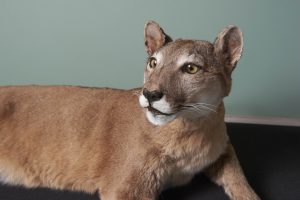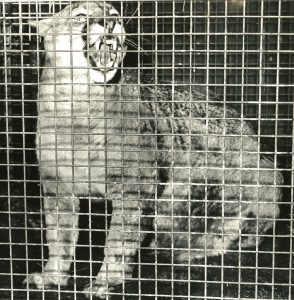
Felicity the puma at Inverness Museum and Art Gallery
Image by Ewen Weatherspoon, © Inverness Museum and Art Gallery
Big Cat captured
On 29 Oct 1980 a puma was captured in a cage-trap near Cannich, Glen Affric, by farmer Donald ‘Ted’ Noble of Kerrow Farm. He had set the trap, baited with sheep’s offal, in the hope of capturing firm evidence to back up years of big cat sightings in the area.
Ted’s elderly neighbour, Jessie Chisholm of Tomich, had first reported an encounter with a big black cat in 1976. Over the following years she made several reports of having seen and heard different big cats around the forest near her cottage. Other witnesses’ accounts also reported big cats being seen and heard in the area, and of livestock being killed, yet no conclusive evidence was found. Mr Noble had suffered livestock losses of his own and had even seen a big cat stalking his Shetland ponies. So he devised the plan to lay a trap on Miss Chisholm’s grounds.
Almost immediately it was suspected that the captured puma was not the wild beast they were looking for but a pampered pet. Had she escaped or been abandoned, or even been planted in the trap as an elaborate hoax on Mr Noble? Experts estimated that the female puma had been roaming wild for less than 48 hours. She was obese, contented and unexpectedly tame. Furthermore, this puma did not match the descriptions given by Jessie Chisholm and the other eyewitnesses. Further sightings continued to be made.

Felicity just after capture in 1980
© Northern Constabulary
Felicity finds a home
Following capture, the puma was given a home at the Highland Wildlife Park where staff named her Felicity. She became a popular attraction and the subject of many letters to Mr Eddie Orbell, the Park Director. Her behaviour was studied during her time at the Park and she was described by Mr Orbell as “very tame indeed”. It is reported that within days she was playing with the children of one of the Keepers. Donald Mitchell, her Keeper, could often be seen walking round the Park with her slung across his shoulders. Keepers also found they had to prepare her food as she would not eat the unskinned rabbits offered. This provided further evidence that she had been hand-reared and was unlikely to be the cause of the livestock predation.
In January 1985, Felicity died peacefully in her sleep at the Highland Wildlife Park. She had taken ill the day before and vets had been called in, but there was nothing they could do. Following the autopsy, it was estimated that she was approximately 20 years old and had died of old age. In the wild a puma’s lifespan is about 12 years. The autopsy findings also supported the theory that she had been raised as a pet and been overfed when young.
Becoming a Museum Celebrity
With authorisation from the Inverness District Council’s Legal Department, Felicity was sent to Edinburgh to be studied and prepared by taxidermist Philip Howard. She is mounted in a relaxed reclining pose – the staff of Highland Wildlife Park had requested that she not be mounted in a snarling pose because she had been ‘a loveable and gentle beast’. The Scottish Museums Council awarded a 50% grant to Inverness Museum towards the taxidermy costs. In 1986 she went on display in the museum’s foyer, where she remained a star attraction for many years.
In 1995 she had a trip to Croydon, featuring in an exhibition entitled Of Monsters and Miracles which included a display on big cat sightings. The exhibition was a collaboration between Croydon Museums Services and The Fortean Times, the journal of strange phenomena. Across the length and breadth of the country there are records and stories of big cat sightings, but Felicity is probably the most famous big cat capture in the UK. The mystery has never been solved as to Felicity’s real origins.
Pumas
Pumas (scientific name: Puma concolor, formerly Felis concolor) are also known as cougars and mountain lions and many other names. In fact pumas hold the Guinness World Record for the most English-language names of any animal – 40 in total. They are native across the length of the American continents, from Canada in North America to Patagonia at the bottom of South America. This is the widest distribution of any big cat. Their success is due to their ability to adapt to different habitats, as they are found living in mountains, plains, forests and deserts. As carnivores they will eat anything from small mammals and birds to larger prey such as deer and goats, and they will also take carrion if it is available.
Reference
Accession number: INVMG.1985.145
Selected Sources
1983 Cat Country: The Quest for the British Big Cat by Di Francis, David & Charles (Publishers) Ltd.
07.02.1985 Press & Journal “Felicity, the tame wild puma, dies”
07.02.1985 Daily Record “Puma found dead”
23.09.1985 The Scotsman “Puma mystery to live on”
10.01.1986 Inverness Courier “Cannich Puma now in Museum”
11.01.1986 Highland News “Stuff it says the grinning growler”
1989 Discover Scotland “The Urquhart Puma”
11.1993 Wildlife Magazine “The Cats of the Baskervilles”
05.08.1995 [Inverness?] Courier “Highland puma going south for star part”
15.12.1998 Inverness Courier “Death of man who caged ’wild’ puma”
28.10.2020 Press & Journal “Big cats: The hunt for the puma caught in the Highlands in 1980”

